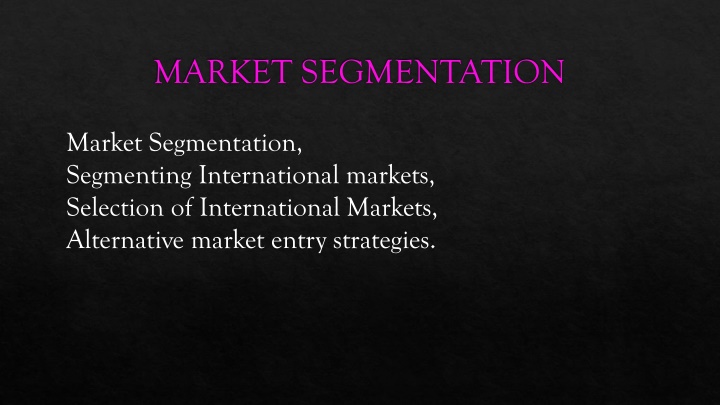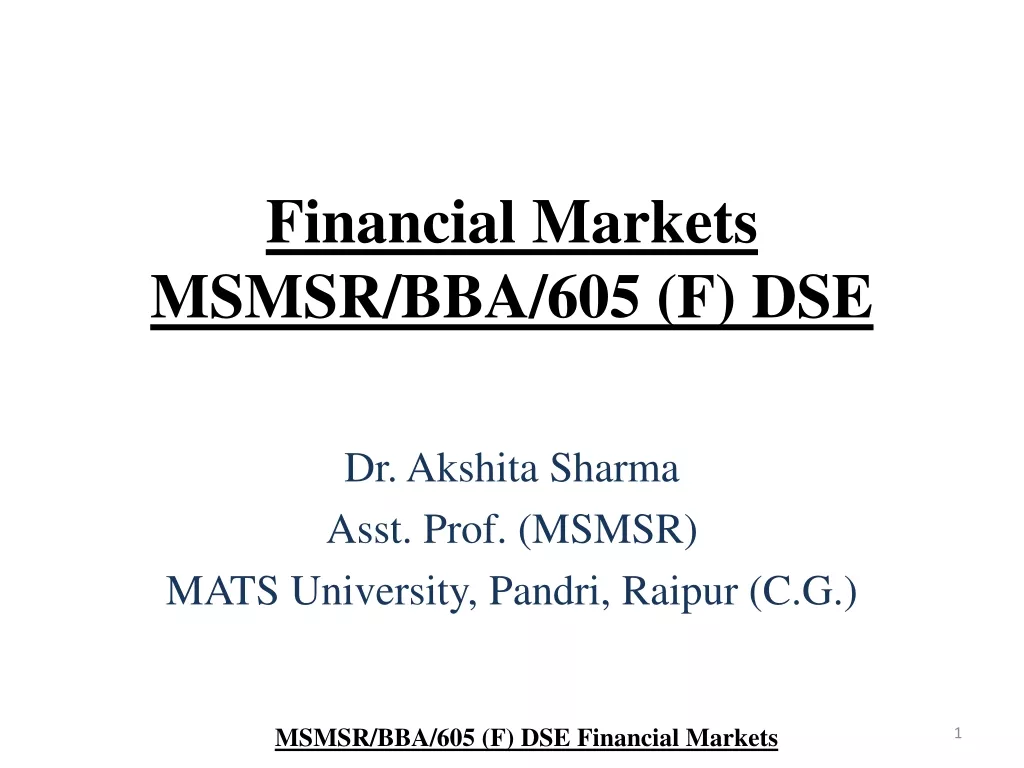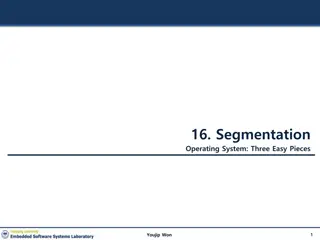Unlocking International Markets: Segmentation and Entry Strategies
Market segmentation plays a vital role in targeting international markets effectively. By segmenting customers based on various criteria, businesses can tailor their strategies to different market segments. This allows for the selection of the most suitable international markets and the implementation of appropriate entry strategies for successful market penetration.
Download Presentation

Please find below an Image/Link to download the presentation.
The content on the website is provided AS IS for your information and personal use only. It may not be sold, licensed, or shared on other websites without obtaining consent from the author.If you encounter any issues during the download, it is possible that the publisher has removed the file from their server.
You are allowed to download the files provided on this website for personal or commercial use, subject to the condition that they are used lawfully. All files are the property of their respective owners.
The content on the website is provided AS IS for your information and personal use only. It may not be sold, licensed, or shared on other websites without obtaining consent from the author.
E N D
Presentation Transcript
MARKET SEGMENTATION Market Segmentation, Segmenting International markets, Selection of International Markets, Alternative market entry strategies.
What is market segmentation? Market segmentation is a technique you can use to divide your customer base into subgroups based on shared characteristics, such as age, income, hobbies, and location. The aim of segmentation is to tailor marketing efforts to your ideal customer profile (ICP), i.e. the customers most likely to buy your product or service.
CHARACTERISTICS OF SEGMENT Measurable size, purchasing power, characteristics Substantial- segment which is sufficient to give profit. Accessible segment has effective reach to customers and the ability to serve. Differentiable segment must give different responses not the same Actionable marketing mix must be accepted by the region and attract segment.
Why is a market segmentation strategy important? According to Bain and Company, businesses that tailor strategies to customer segments generate yearly profit growth of 15% vs 5% for businesses that don t. In short, market segmentation can drive significant growth. Segmentation techniques are major profit drivers because they help you define your target market and qualify customers as users of your product or service. You can then provide the personalization that 73% of shoppers now expect from brands sending the right message, through the right channel, at the right time. Market segmentation also helps you to: Enter new markets Build products that solve customer pain points Streamline sales processes Drive more revenue from email marketing Drive more revenue from social media marketing Increase customer retention
Bases of segmenting Consumer Markets Demographic segmentation Psychographic segmentation Geographic segmentation Behavioral segmentation
1. Demographic segmentation: The who Widely used by D2C e-commerce brands, demographic segmentation is one of the most simple yet effective kinds of segmentation. You can use demographic segmentation to split your audience and create customer personas based on objective information, such as: Age Gender Income Level of education Religion Profession/role in a company
For example, if you segment your audience based on your customers income, you can target them with products that fall within the constraints of their budget. If you re a small business or new to ecommerce, this is a straightforward type of segmentation with three key advantages: It s easy to collect information It s simple to measure & analyze It s cost-effective
2. Psychographic segmentation: The why Psychographic segmentation is the process of grouping people together based on similar personal values, political opinions, aspirations and psychological characteristics. For example, you can group customers according to their: Personality Hobbies Social status Opinions Life goals Values and beliefs Lifestyle Because these characteristics are subjective, psychographics is a harder segment to identify but it s also the most valuable. The best places to gather data for psychographic segmentation are through your audience analytic tools and social media, but you should also use surveys, interviews ,and focus groups to strengthen your customer understanding in this segment. Through psychographic segmentation, you can get a deep insight into your customers likes, dislikes, needs, wants and loves. You can then create marketing campaigns that resonate with their psychographic profile.
3. Geographic segmentation: The where Geographic segmentation is the process of grouping customers based on where they live and where they shop. People who live in the same city, state or zip code typically have similar needs, mindsets and cultural preferences. The real advantage of geographic segmentation is it provides an insight into what your customers location says about a number of geo-specific variables, such as their: Climate Culture Language Population density (urban vs rural) As with all market segmentation methods, you ll need to analyze your data to understand how each factor influences your customers shopping behavior. For example, people living in colder climates are likely to be in the market for winter clothing and home heating appliances. You can also use geographic segmentation to solve practical problems.
4. Behavioral segmentation: The how Behavioral segmentation is the process of grouping customers based on common behaviors they exhibit when they interact with your brand. For this type of segmentation, you can group your audience based on their: Spending habits Purchasing habits Browsing habits Interactions with your brand Loyalty to your brand Product feedback
Gather this objective data through your website analytics and you can identify patterns in your customers behavior that help predict how they ll interact with your brand in the future. Then you can leverage this hypothesis to provide personalized recommendations that address your customers needs. For example, Spotify provides its users with curated daily mixes based on the types of genres and artists they ve listened to previously. At Yieldify, we use behavioral segmentation to deliver highly relevant and targeted campaigns based on behaviors including: Number of sessions to your website Number of pages visited Time spent on site URLs visited Page types visited Exit intent Inactivity Shopping cart value Campaign history Referral source For example, Petal & Pup tailor their email lead generation messaging for visitors arriving from Facebook.
Benefits of Market Segmentation Increased resource efficiency. Marketing segmentation allows management to focus on certain demographics or customers. Instead of trying to promote products to the entire market, marketing segmentation allows a focused, precise approach that often costs less compared to a broad-reach approach. Stronger brand image. Marketing segment forces management to consider how it wants to be perceived by a specific group of people. Once the market segment is identified, management must then consider what message to craft. Because this message is directed at a target audience, a company s branding, and messaging are more likely to be very intentional. This may also have an indirect effect of causing better customer experiences with the company. Greater potential for brand loyalty. Marketing segmentation increases the opportunity for consumers to build long-term relationships with a company. More direct, personal marketing approaches may resonate with customers and foster a sense of inclusion, community, and a sense of belonging. In addition, market segmentation increases the probability that you land the right client that fits your product line and demographic. Stronger market differentiation. Market segmentation gives a company the opportunity to pinpoint the exact message they way to convey to the market and to competitors. This can also help create product differentiation by communicating specifically how a company is different from its competitors. Instead of a broad approach to marketing, management crafts a specific image that is more likely to be memorable and specific. Better targeted digital advertising. Marketing segmentation enables a company to perform better-targeted advertising strategies. This includes marketing plans that direct efforts towards specific ages, locations, or habits via social media.
Limitations of Market Segmentation Higher upfront marketing expenses. Marketing segmentation has the long-term goal of being efficient. However, to capture this efficiency, companies must often spend resources upfront to gain insight, data, and research into their customer base and the broad markets. Increased product line complexity. Marketing segmentation takes a large market and attempts to break it into more specific, manageable pieces. This has the downside risk of creating an overly complex, fractionalized product line that focuses too deeply on catering to specific market segments. Instead of a company having a cohesive product line, a company's marketing mix may become too confusing and inconsistently communicate its overall brand. Greater risk of misassumptions. Market segmentation is rooted in the assumption that similar demographics will share common needs. This may not always be the case. By grouping a population together with the belief that they share common traits, a company may risk misidentifying the needs, values, or motivations of individuals of a given population. Higher reliance on reliable data. Market segmentation is only as strong as the underlying data that support the claims that are made. This means being mindful of what sources are used to pull in data. This also means being conscious of changing trends and when market segments may have shifted from prior studies.
Selection of International Markets 1. Check Economic Stability and Political Stability There is no tried and true rule of thumb for the best market to enter, although experts do agree that a country s economic and political stability is one of the first indicators of market potential. An economy with constant output growth, low and stable inflation is considered economically stable, while an economy with frequent, large-scale recession, pronounced business cycles, high inflation, or frequent financial crises is considered unstable. Political stability refers to the regularity of political exchanges. The more political changes happen in a country, the less stable it is. If a country is economically and politically stable, there is high market potential, measured in terms of market size, purchasing power, and currency stability. On the other hand, in countries with low economic and political stability, there is limited market potential. Quantitatively measuring the economic and political stability of a country is not easy and should only be undertaken by experts. However, business managers can totally gain access to all of the information about the macroeconomic and political events that happen in a country. They can base their decisions on those events.
he following key questions can be used as a guide to select a stable market to invest in: Which international market is of interest to the firm? Which markets should be excluded because of their political risks? Which remaining markets have non-favorable regulatory environment? Which remaining markets have stable inflation and low risk of recession? Which remaining markets have sustainable growth in recent years? Once you have answered all of these questions, you should have narrowed your target list to about 10-20 countries. After that, you can start to analyze your firm, brand, or product from various angles to determine the right market for your product.
2. Narrow Your Market Selection With Macro- criteria 2. Narrow Your Market Selection With Macro-criteria Once you have in your hands a list of countries that you think to be most prospective, you can start to narrow your selection with macroeconomic criteria. Although most of these criteria have been included in the Stability index that we discussed in the firstsection, a second look is more than necessary. Specifically, we want to look at: GDP Growth: the country s current GDP, its growth rate, and its performance within the last decade Political Risk:including risks of social unrest Business Freedom:including the degree of intervention by the government into doing business International Relations:including the relationship of that specific country with other countries in its region and the world. Is it perceived in a positive/negative/neutral light by its neighboring/alliances? What are some countries that you should always put on watch onceyou do business there? Geographic Factors:Is the country situated in a booming/rapidly-growing region? Is there any logistical difficulties when it comes to manufacturing/delivering your products/services? Culture:Is there many similarities between your country and that country? How do the people there think of your country? Are they friendly or hostile towards your country? Is there any cultural differences that you need to be aware of? Business Culture:Business Culture is a part of the umbrella term culture , but it still deserves a mention. Is there too big of a difference in management philosophy between your country and that country? What is the approach to doing business in each country? Are there any similarities? How can we reconcile the differences in culture?
3. Decide Whether You Want To Be Specific Or Diverse With Your Market Selection 3. Decide Whether You Want To Be Specific Or Diverse With Your Market Selection It s better to be specific than be broad. But sometimes it s better to be broad than specific. There is no true answer to this. Many entrepreneurs went too broad with their market selection, and try to include a wide range of industries in their offerings,especially service companies. When you extend your targeted market to many industries, you are essentially upping your potential profit cap. However, that also means you re allocating your resources to too many areas at the same time. By carving out a niche for yourself, you ll have an easier and faster time getting clients, but your cap is definitely lower. They argue that you can always scale your business up later. That is true, but by being so focused on one industry, you also carry a higher risk of market failure. Don t put your eggs into one basket is the motto that all investors live by. Advantages of being specific in your choice of markets: Consolidate your market s presence in those industries Stronger brand awareness
Constant sales growth Gain in-depth knowledge of that market Reduced costs on logistics and management More resources can be dedicated to marketing and production Stronger risk control When should you go specific with your market selection: Your products and services only serve a very specific set of customers You have a competitive advantage against other competitors in that market Company has limited resources and can only dedicate to one or a few markets at the same time Your company needs time to familiarize itself with the new business environment Advantages of being diverse in your choice of markets: Rapid sales and growth Price differentiation Risk diversification When should you go diverse with your market selection: The global demand for your product or service is spread out across many markets High competition and reduced number of customers in each market Product has a long lifecycle Company has large resources that can be dedicated to several areas at once
4. Identify Market Gaps Every successful business you can think of has served some market gaps in the market they are in. Market Gaps are essentially untapped potential that your company can wriggle in and take advantage of. They are attractive opportunities that other businesses haven t realized, andif you managed to find some, it is crucial that you make a quick move to capture the market share. Understand Your Competitive Advantage:How can we identify market gaps? You must first know exactly where your strengths lie. Consider the following question: What makes your product/brand stand out from your competitors? What do you have that your competitors don t? What was the biggest success you have ever had on the journey of developing this brand/product? What do your past customers/clients have to say about your brand/product? What are the feedbacks your clients gave you? Although these questions may seem insignificant, they can actually give you a lot of refreshing insights that can later be used. Conduct A Thorough Market Research:Once youknowwhat you have to offer, you can conduct a market research to find out if your customers actually want to buy your products. Who needs what you are offering? Is there market saturated? Are there competing firms well entrenched in the market? Is the market national or regional? Is your niche well-developed or untapped? What is your ideal customer?
5. Further Narrow Your Target Market Down With Micro-Criteria We have been looking only at macro-criteria so far. Once you get to know your business more clearly, you can start to select markets that suit your company more and more closely. Consider the following criteria when choosing a suitable market for your business: Modernization Level:does the country have enough technology to support your business? Labor Cost (if you plan to establish a manufacturing business in that country):sometimes, for manufacturing companies, labor cost is the only criterion that they look at when choosing a country to expand into. Labor Quality: in some countries, especially developing countries, labor quality sometimes can t meet up with the standards of foreign companies. In this scenario, these foreign companies may either leave for another company with higher labor quality, or they ll stay and invest into labor training if they see that the future benefit is greater. Tax Benefits:governments from many countries offer tax incentives for foreign companies that invest in the high-tech sector, or sectors that aren t well-developed in their region. Cost of Real Estate:it s worth your time to learn a thing or two about the real estate law of that country and prepare yourself for the best deals there. Physical Infrastructure Financial Infrastructure Availability of Suppliers Cost of Living
Availability of Competitors: once you have determined your market and your niche clearly, you should be able to come up with a list of your competitors. Categorize them into smaller competitors, equal competitors, and bigger competitors. Describe them statistically. Analyze their performance in the last few years, and forecast their growth as well as orientation. Pinpoint some of their most distinguishing factors: prices, channels, market utility, financial positions, development potential, and expansion strategies Crime Rate Utility Cost Connection with other Regions: determine if the specific location that you re about to expand to is situated in proximity with other high-developing regions or not. Availability of Demand Legal Environment: consider the legal complexities that you may have to get yourself into if you decide to establish a business there. Know the differences between the law in your country and theirs. In some countries, there are very specific and unique regulations as to how you should run a business, and it s better to learn a thing or two about them. If the country you re about to enter is heavily bureaucratic, embrace yourself for the lengthy time it takes to simply register your company. Distribution Channel: determine how you re going to expand in this market. Is there an international distribution channel from your country to their country? If you re approaching the market with a local production strategy, is the logistics in that country developed enough to handle y
ALTERNATIVE MARKET ENTRY STRATEGIES 1. Exporting Exporting involves marketing the products you produce in the countries in which you intend to sell them. Some companies use direct exporting, in which they sell the product they manufacture in international markets without third-party involvement. Companies that sell luxury products or have sold their goods in global markets in the past often choose this method. Alternatively, a company may export indirectly by using the services of agents, such as international distributors. Businesses often choose indirect exporting if they're just beginning to distribute internationally. While companies pay agents for their services, indirect exporting often results in a return on investment (ROI) because the agents know what it takes to succeed in the markets in which they work. 2. Piggybacking If your company has contacts who work for organizations that currently sell products overseas, you may want to consider piggybacking. This market entry strategy involves asking other businesses whether you can add your product to their overseas inventory. If your company and an international company agree to this arrangement, both parties share the profit for each sale. Your company can also manage the risk of selling overseas by allowing its partner to handle international marketing while your company focuses on domestic retail.
3. Countertrade Countertrade is a common form of indirect international marketing. Countertrading functions as a barter system in which companies trade each other's goods instead of offering their products for purchase. While legal, the system does not have specific legal regulations like other forms of market entry do. This means companies may solve problems like ensuring other companies understand the value of their products and attempting to acquire goods at a similar level of quality. Countertrading is a cost-effective choice for many businesses because the practice may exempt them from import quotas. 4. Licensing Licensing occurs when one company transfers the right to use or sell a product to another company. A company may choose this method if it has a product that's in demand and the company to which it plans to license the product has a large market. For example, a movie production company may sell a school supply company the right to use images of movie characters on backpacks, lunchboxes and notebooks. 5. Joint ventures Some companies attempt to minimize the risk of entering an international market by creating joint ventures with other companies that plan to sell in the global marketplace. Since joint ventures often function like large, independent companies rather than a combination of two smaller companies, they have the potential to earn more revenue than individual companies. This market entry strategy carries the risk of an imbalance in company involvement, but both parties can work together to establish fair processes and help prevent this issue.
6. Company ownership If your company plans to sell a product internationally without managing the shipment and distribution of the goods you produce, you might consider purchasing an existing company in the country in which you want to do business. Owning a company established in your international market gives your organization credibility as a local business, which can help boost sales. Company ownership costs more than most market entry strategies, but it has the potential to lead to a high ROI. 7. Franchising A franchise is a chain retail company in which an individual or group buyer pays for the right to manage company branches on the company's behalf. Franchises occur most commonly in North America, but they exist globally and offer businesses the opportunity to expand overseas. Franchising typically requires strong brand recognition, as consumers in your target market should know what you offer and have a desire to purchase it. For well-known brands, franchising offers companies a way to earn a profit while taking an indirect management approach. 8. Outsourcing Outsourcing involves hiring another company to manage certain aspects of business operations for your company. As a market entry strategy, it refers to making an agreement with another company to handle international product sales on your company's behalf. Companies that choose to outsource may relinquish a certain amount of control over the sale of their products, but they may justify this risk with the revenue they save on employment costs. 9. Greenfield investments Greenfield investments are complex market entry strategies that some companies choose to use. These investments involve buying the land and resources to build a facility internationally and hiring a staff to run it. Greenfield investments may subject a company to high risks and significant costs, but they can also help companies comply with government regulations in a new market. These investments typically benefit large, established organizations as opposed to new enterprises. 10. Turnkey projects Turnkey projects apply specifically to companies that plan, develop and construct new buildings for their clients. The term "turnkey" refers to the idea that the client can simply turn a key in a lock and enter a fully operational facility. You might consider this market entry strategy if your clients comprise foreign government agencies. International financial agencies usually manage arrangements between companies and their overseas clients to ensure the companies provide high-quality service and the client pays the full amount due.






















